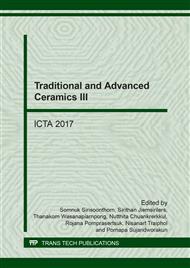p.228
p.233
p.241
p.246
p.252
p.258
p.264
p.270
p.276
Feasibility Study of Using Basalt Fibers as the Reinforcement Phase in Fiber-Cement Products
Abstract:
The aim of this work was to study the feasibility of using basalt fibers as the reinforcement phase in fiber-cement products which was the fiber-reinforced construction materials used for roof, wall, ceiling, and floor applications. The feasibility study included (1) the alkaline resistant test of the basalt fibers by soaking the basalt fibers in 1 N Ca(OH)2 up to 28 days, and (2) the mechanical test based on ASTM C1185 standard on the fiber-cement board that used basalt fibers as a reinforcement phase. Scanning electron microscope (SEM) and x-ray diffractometer (XRD) were used to characterize the basalt fibers after alkaline resistant test. The basalt-fiber reinforced cement board was produced on the industrial level by using Hatschek process.From the alkaline resistant test, basalt fibers had well alkaline resistant. From the mechanical test, the modulus of rupture (MOR) of basalt-fiber reinforced cement boards passed the requirement of TIS 1427-2540 and ASTM C1186 standard. Therefore, basalt fibers could be considered as a good candidate for using as a reinforcement phase in the fiber-cement products.
Info:
Periodical:
Pages:
252-257
Citation:
Online since:
April 2018
Keywords:
Price:
Сopyright:
© 2018 Trans Tech Publications Ltd. All Rights Reserved
Share:
Citation:


